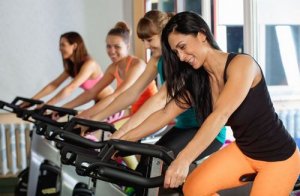Choosing The Right Resistance in Spinning Classes

Spinning is in and it is one of the most popular gym workouts. Beginners and those with experience should keep some basic rules in mind. That includes knowing how to select the right resistance in spinning classes.
Spinning is beneficial for many parts of the body, such as the glutes, calves, and quadriceps. It is also great for your lung and cardiovascular health.
Generally, anyone of any fitness level can sign up for spinning classes. Under the right supervision and by choosing the right resistance in spinning classes, even those with light back pain could do it. Spinning only conflicts those with heart problems.

Getting to know the spinning bike
You can encounter different resistance systems depending on the equipment. The most popular one is friction resistance located on a wheel or axle. The greater the load force, the more the person will be able to feel the contact. This translates into needing to push more to be able to pedal.
The second type uses a flywheel that makes the wheel spin. The force you need to use is proportional to the speed; the faster you need to go, the more you will need to push.
Finally, some more recent spinning bike models use magnetic resistance. As such, it is more durable since there are not any parts that come into contact with constant friction.
Choosing the right resistance in spinning classes
There are instructors that guide their attendees according to their levels. They tell them how much resistance to use. However, not all instructors use these kinds of uniform measures.
For one, not all equipment works the same way. These variations play a role in their maintenance, as well as for how long and how to use the bikes.
Those who are against uniform resistance also note that a person’s condition changes every day. There are days when they might feel energized, optimistic, and ready to take on the world. Then, there are days when fatigue limits their performance and just getting on the bike is a chore.

As such, it is all up to how each person feels. To choose the right resistance in spinning classes, you have to pedal and see how it feels.
Resistance levels
Every spinning session starts and ends with the lowest resistance. Initially, it is to warm up and prepare the body. The lowest setting is then used to let your muscles relax progressively before getting off the bike.
In addition, there are four other levels:
- Medium to low intensity: a little more difficult than the lowest level but still comfortable and manageable.
- Medium resistance: requires more effort. You can feel the burn but without being completely exhausted. You should still be able to control your breathing rate.
- Medium to high intensity: to keep up the pace without slowing down, you will have to put in even more effort. At your best, along with the instructor’s motivation and encouragement, you should be able to go even harder.
- High resistance: enduring this resistance is always a challenge. And the same goes for experienced people who are in great shape.
Setting up and preventing injuries
In addition to choosing the right resistance in spinning classes, you have to set up your bike correctly to fully benefit from these aerobic sessions. First, set the seat height by standing next to the bike. The seat should be at the same height as your hips.
You should also adjust the handlebar, which should be parallel to the seat or slightly higher. This way, you will not be straining your shoulders and it will be easier to keep your back straight.
Finally, don’t forget to stay hydrated before and after your spinning sessions.
Many injuries that people have from indoor cycling or spinning are easily preventable by drinking enough water.
Spinning is in and it is one of the most popular gym workouts. Beginners and those with experience should keep some basic rules in mind. That includes knowing how to select the right resistance in spinning classes.
Spinning is beneficial for many parts of the body, such as the glutes, calves, and quadriceps. It is also great for your lung and cardiovascular health.
Generally, anyone of any fitness level can sign up for spinning classes. Under the right supervision and by choosing the right resistance in spinning classes, even those with light back pain could do it. Spinning only conflicts those with heart problems.

Getting to know the spinning bike
You can encounter different resistance systems depending on the equipment. The most popular one is friction resistance located on a wheel or axle. The greater the load force, the more the person will be able to feel the contact. This translates into needing to push more to be able to pedal.
The second type uses a flywheel that makes the wheel spin. The force you need to use is proportional to the speed; the faster you need to go, the more you will need to push.
Finally, some more recent spinning bike models use magnetic resistance. As such, it is more durable since there are not any parts that come into contact with constant friction.
Choosing the right resistance in spinning classes
There are instructors that guide their attendees according to their levels. They tell them how much resistance to use. However, not all instructors use these kinds of uniform measures.
For one, not all equipment works the same way. These variations play a role in their maintenance, as well as for how long and how to use the bikes.
Those who are against uniform resistance also note that a person’s condition changes every day. There are days when they might feel energized, optimistic, and ready to take on the world. Then, there are days when fatigue limits their performance and just getting on the bike is a chore.

As such, it is all up to how each person feels. To choose the right resistance in spinning classes, you have to pedal and see how it feels.
Resistance levels
Every spinning session starts and ends with the lowest resistance. Initially, it is to warm up and prepare the body. The lowest setting is then used to let your muscles relax progressively before getting off the bike.
In addition, there are four other levels:
- Medium to low intensity: a little more difficult than the lowest level but still comfortable and manageable.
- Medium resistance: requires more effort. You can feel the burn but without being completely exhausted. You should still be able to control your breathing rate.
- Medium to high intensity: to keep up the pace without slowing down, you will have to put in even more effort. At your best, along with the instructor’s motivation and encouragement, you should be able to go even harder.
- High resistance: enduring this resistance is always a challenge. And the same goes for experienced people who are in great shape.
Setting up and preventing injuries
In addition to choosing the right resistance in spinning classes, you have to set up your bike correctly to fully benefit from these aerobic sessions. First, set the seat height by standing next to the bike. The seat should be at the same height as your hips.
You should also adjust the handlebar, which should be parallel to the seat or slightly higher. This way, you will not be straining your shoulders and it will be easier to keep your back straight.
Finally, don’t forget to stay hydrated before and after your spinning sessions.
Many injuries that people have from indoor cycling or spinning are easily preventable by drinking enough water.
This text is provided for informational purposes only and does not replace consultation with a professional. If in doubt, consult your specialist.








